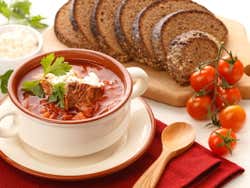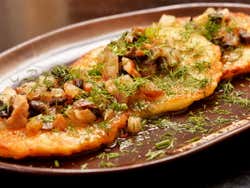
Where to eat in Moscow
Vodka, caviar, borscht... the list of Russian delicacies goes on! Discover where, when and what to eat during your trip to Moscow.
Moscow's restaurants, bars and cafes have dishes to suit all tastes and budgets, allowing everyone to sample the best of Russian cuisine! With a wealth of flavours reflecting the multiculturalism of the country, Moscow's gastronomy is based in simple and tasty ingredients that can survive cultivation in an extremely cold climate. We've compiled a list of some of the top Russian delicacies so you can decide what try during your trip!
What to eat in Moscow?
- Borscht: the iconic beetroot soup, beloved across Slavic countries. You'll sometimes find it with beef, ham and sausage added in Moscow.
- Pelmeni: Eastern Europe is well known for its dumplings, and Russian pelmeni stand out for their semi-circular shape and super-thin dough stuffed with minced meat, onion and herbs.
- Vareniki: also called pierogi, these filled dumplings can be sweet or savoury: think potato, sauerkraut, minced meat and or cheese, or various fruits, all generally served with sour cream.
- Blini: traditional wafer-thin Russian pancakes made from wheat or buckwheat flour. They're eaten savoury (with caviar and sour cream, for example) or sweet (with jam and sour cream) and served folded or rolled up on your plate.
- Olivier salad: known elsewhere in the world as Russian salad, this is a mix of chopped chicken or ham, mixed with potatoes, eggs, peas and mayonnaise.
- "Self pod shuboy" ("herring in a fur coat"): another popular salad for Russians, this is a colourful dish of herring, beets and potatoes.
- Beef Stroganoff: like many main dishes in Moscow, the world-famous Stroganoff (named after a Russian noble family) is heavy and meaty. The sautéed beef in a sour cream sauce is usually served with rice. Other popular mains include shashlyk (kebabs) and zharkoye (hot pot), great for warming you up if you visit in winter!
- Smetana: as you might have guessed, the Russians love their sour cream, known as smetana: it goes on everything, from soup to blinis!
- Caviar: ikra, as it's called in Russia, was traditionally the snack of the Tsars and the rich. It is still expensive, especially if you buy black caviar from the beluga sturgeon, although red salmon caviar is cheaper. It's eaten on buttered bread and washed down with vodka or champagne!
- Kvass: a fermented non-alcoholic beverage made from rye bread, and often flavoured with fruits or herbs.
- Vodka: the iconic Russian drink tastes different here. It's drunk as a shot and often chased down with a pickle, and if you're pouring the drinks, you make the toast. Za zdorovie!
Where to eat in Moscow?
So you know what you're going to eat, now where's best to try it? When it comes to choosing cafes, bars and restaurants, if you're looking for a quick and cheap option, the two biggest chains are Teremok, which offers blinis for all tastes, and Kroshka Kartoshka, whose speciality is potatoes made in every possible way!
If you happen to visit the GUM Galleries in Red Square at lunchtime, you might want to take the opportunity to visit the Stolovaya 57 restaurant, an economical option amongst the luxury of this elegant shopping centre.
One of the most widespread food chains in the city is My-My. Offering basic and budget-friendly dishes in a self-service format, these cafeterias are a quick, cheap and good quality option, and easily recognisable by the figure of a black and white cow on the door! The traditional taverns in the Yolki Palki chain are another good choice to enjoy typical Russian food at very affordable prices. Plus, the advantage of self-service restaurants is that you can point to the foods you want, avoiding the language barrier!
When to eat in Moscow?
In Russia, mealtimes are relatively extended. Restaurants in Moscow are usually open between midday and 4 pm for lunch, and between 6 pm and 11 pm for dinner, although you'll probably find a fair few places that are open for 24 hours.

